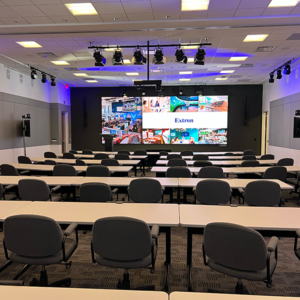In today’s increasingly connected world, the lines between audiovisual (AV) technology and information technology (IT) are becoming increasingly blurred. As organizations across various sectors grapple with the rapid pace of technological advancement, a new paradigm is emerging – one where AV and IT are no longer separate entities, but rather two sides of the same coin.
This shift is particularly evident in higher education, where the traditional roles of IT departments are expanding to encompass a wide range of AV responsibilities. From managing network-connected projectors to orchestrating complex video streaming setups, IT professionals are finding themselves at the forefront of a technological convergence that’s reshaping the way we think about both fields.
The Rise of the IT/AV Hybrid
As AV technology becomes more sophisticated and network-dependent, many organizations are creating hybrid IT/AV roles to bridge the gap between these once-distinct domains. These new positions often require a unique blend of skills, combining traditional IT certifications with AV-specific qualifications like the Certified Technology Specialist (CTS) certification from AVIXA.
This trend is particularly pronounced in educational institutions, where budget constraints and the need for efficient resource allocation are pushing departments to consolidate their tech support functions. In K12, the days of having a dedicated AV tech are long gone, and it’s getting to that point in Higher ED and corporate. It’s all under IT because the need for carts of projectors rolled into a room and expertly set up is gone, with computers connected to in-room projectors.
The Challenges of Convergence
While the integration of AV and IT offers numerous benefits, it’s not without its challenges. Many IT professionals find themselves suddenly responsible for complex AV setups without the specialized training traditionally associated with the field. This can lead to frustration and a steep learning curve as IT departments adapt to their expanded roles.
Projector alignment, acoustics, or troubleshooting a video wall are just a few “AV-centric” skills that IT is now responsible for knowing. Or at least having someone on staff who does. These specialized tasks underscore the need for ongoing training and skill development as the worlds of AV and IT continue to merge.
The Network Effect
One of the primary drivers behind the AV-IT convergence is the increasing reliance on network connectivity for AV devices. From IP-enabled projectors to networked audio systems, modern AV equipment often requires the same level of network management and security considerations as traditional IT infrastructure. Additionally, you have the rise in popularity of AV over IP where not just
Almost every Audio Visual devices are IP enabled for connectivity and administration,. This network integration not only simplifies device management but also opens up new possibilities for centralized control and automation of AV systems.
The Future of AV/IT Integration
As we look to the future, it’s clear that the trend towards AV/IT integration is likely to continue. However, there’s ongoing debate about the extent to which these fields should merge and the best organizational structures to support this convergence.
Some argue for complete absorption of AV into IT departments, citing the increasing overlap in technologies and the need for streamlined support processes. Others advocate for a more nuanced approach, where AV remains a distinct specialty within the broader IT umbrella, allowing for the preservation of specialized skills while benefiting from closer collaboration with IT teams.
If you just “follow the money” you would tend to be in the camp that AV is IT. I’m hesitant to use all so I’ll merely say almost all AV purchases are made with IT budgets.

The Human Element
Amidst all the talk of technology and integration, it’s important not to lose sight of the human element in this equation. The convergence of AV and IT is not just about managing devices and networks – it’s about creating seamless, intuitive experiences for end-users.
In many organizations, IT departments are finding themselves on the front lines of user support, not just for traditional computing issues but also for AV-related challenges. AV support these days is as much ‘teach me how to use Windows/Teams’ as it is ‘I have an actual AV problem,. This highlights the expanding scope of tech support in the age of AV/IT convergence.
A Call for Collaboration
As the debate over AV/IT integration continues, one thing is clear: the need for increased collaboration between AV specialists and IT professionals has never been greater. Whether operating as distinct departments or as part of a unified team, the complex challenges of modern technology environments demand a collaborative approach that leverages the strengths of both disciplines.
By fostering a culture of mutual respect and knowledge sharing, organizations can navigate the complexities of this technological convergence and unlock new possibilities for innovation and efficiency. As we move forward into this new era of integrated technology management, the ability to bridge the gap between AV and IT will likely become a key differentiator for organizations across all sectors.
In the end, the convergence of AV and IT is not just about technology – it’s about reimagining the way we approach problem-solving and innovation in an increasingly connected world. As these once-distinct fields continue to merge, we stand on the brink of exciting new possibilities in how we create, manage, and interact with technology in our daily lives.
Tim Albright is the founder of AVNation and is the driving force behind the AVNation network. He carries the InfoComm CTS, a B.S. from Greenville College and is pursuing an M.S. in Mass Communications from Southern Illinois University at Edwardsville. When not steering the AVNation ship, Tim has spent his career designing systems for churches both large and small, Fortune 500 companies, and education facilities.
 العربية
العربية 简体中文
简体中文 Nederlands
Nederlands English
English Français
Français Deutsch
Deutsch Italiano
Italiano Português
Português Русский
Русский Español
Español








